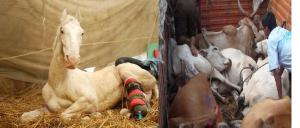We all know Shaktimaan the horse. From March 14 to April 20 this year, between its unfortunate injury and death, it remained a front page news on our lily-pure newspapers. Such love for protection of animals doesn’t extend to illegal cow slaughters. Never ever a word. Instead, cow-protectors are seen as a plot of Hindutva’s agenda. That veneration for cows, without VHP, RSS or BJP prop, doesn’t exist.
Before I am dismissed as a Hindutva foot-soldier, an anti-Dalit, anti-Muslim, anti-beef Hindu fundamentalist, let’s look at Indian constitution’s position. After all, this is where all hysteria should end.
Prohibition of cow slaughter is a Directive Principle of State Policy in Article 48 of the Constitution. It says: “The state shall endeavour…in prohibiting the slaughter of cows and calves and other milch and draught cattle.” On October 26, 2005, the Supreme Court of India upheld the constitutional validity of anti-cow slaughter laws. Only Kerala, West Bengal and India’s northeast don’t have any restrictions on cow slaughter.
Before you burn me at the stake on beef trade, remember most beef produced, consumed and exported is buffalo meat which is not considered sacred to a Hindu. Besides, most cow-slaughterhouses are illegal. It’s a rampant illegal practice where cows are shipped to restriction-free states. Wikipedia says: “In 2013 in Andhra Pradesh, there were 3,100 illegal and 6 licensed slaughterhouses in the state.”
Sure, in practice, States take uneven position on the matter. Delhi, Gujarat, Maharashtra, Madhya Pradesh, Punjab, Rajasthan and Uttar Pradesh have the strictest laws against cow-slaughter. Assam and West Bengal permit slaughter of cows 10-14 years old. In many states though cow-slaughter in a non-bailable offence. The terms of imprisonment could extend from a mandatory 6 months to 5 years.
So get this straight. Cow slaughter makes you a criminal in most of India. And please spare me this Hindutva tag. For cow slaughter was opposed by notable Muslims from the Mughals’ times.
Muslims and cow-slaughter
Emperor Babar ruled in 1526 that killing of cows was forbidden. Akbar (1556-1605), Jahangir (1605-1627), Ahmed Shah (1748-1754) all had restricted bans on cow slaughter. Yes, Aurangzeb deviated but Bahadur Shah Zafar completely banned cow slaughter in 1857. The de facto sultan of Mysore, Hyder Ali (1762-1785), punished cow-slaughter offenders by cutting off their hands.
It’s a fallacy that cow-slaughter in India began with the arrival of Islam. Vedas describe many gods such as Indra and Agni having preference for cattle meat. Sure the various invasions of Islamic rulers around 1000 AD made it common. Along with sacrifices of goats and sheet, cows too became a sacrificial animal, particularly on the occasion of Bakri-Id.
As in most things, British rule in India was trouble. They were used to eating beef. Slaughterhouses sprang up all over India. In 1944, British placed restrictions on slaughter due to cattle shortage. After all, they were required for transport, cultivation and milk among other purposes. But it came too late in the day. A historical survey, between 1717-1977, reveal that out of 167 communal riots, 22 were directly attributed to cow slaughter.
Arya Samaj, which opposed many existing practices of Hinduism in the 19th century, including idol worship, polytheism, child marriage, widow celibacy, the caste system, accepted the cow worship. Dayananda Saraswathi in 1881 opposed cow-slaughter as an anti-Hindu act. In 1683, Sambhaji, the eldest son of Shivaji, is said to have personally executd a cow-slaughter offender.
Ranjit Singh (1801-1839), founder of the Sikh Empire, banned cow slaughter throughout his domains. Cow was as sacred to the Sikhs as to the Hindus. Cow slaughter was a capital offence and offenders were even executed.
Let’s look at the stands of our revered leaders during British Raj. Mahatama Gandhi, Bal Gangadhar Tilak, Lala Lajpat Rai, Madan Mohan Malviya, Dr. Rajendra Prasad all had vowed to ban cow-slaughter in case India got its “Swaraj.” Let’s listen to Gandhi’s words: “Not even to win Swaraj, will I renounce my principle of cow protection…I worship and I shall defend its worship against the whole world. The central fact of Hinduism is cow protection.”
In 1966, Loknayak Jayaprakash Narayan wrote thus to the then Prime Minister Indira Gandhi: “For myself, I cannot understand why, in a Hindu majority country like India…there cannot be a legal (cow slaughter) ban.”
Why Cows Matter
Animals have always been worshipped in India as deities. Elephant-god Ganesh, monkey-god Hanuman, Vishnu’s fish, tortoise and boar forms, their “vahanas” such as swan, bull, lion and tiger were all major deities. As well as snakes out of fear; and crows as the abode of the dead.
Cows are sacred to Hindus as a companion to Lord Krishna. Dairy products have always been essential in Hindu culture. Panchagayya, a mixture of five products of cow milk, curd, ghee, urine and dung, is consumed in Brahmanical rituals. Cows and bull—such as “Nandi”—have been the symbols of Dharma. Owning cattle was—and is—a status symbol in many parts of India. It’s dung is a source of fuel and fertilizer. Hence, its position as a maternal figure—“Gau Mata”– to a Hindu’s mind. Buddhism and Jainism both rooted for cow-protection.
It’s a delicious irony of history that Hindus and Muslims together revolted against the British East India Company in 1857 for being made to use gunpowder greased with cow and pig fat. As cow is sacred to Hindus, the consumption of swine is forbidden in Islam.
So recognize facts as they are. Sure condemn where law is taken into hands. But for god’s sake, don’t think cow-protection is a political manipulation. It’s constitutionally guaranteed and you subvert it at your own peril.


